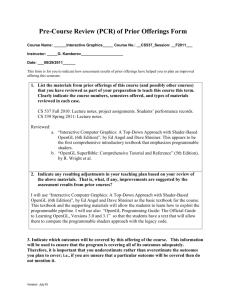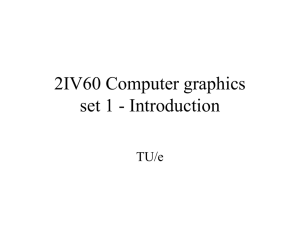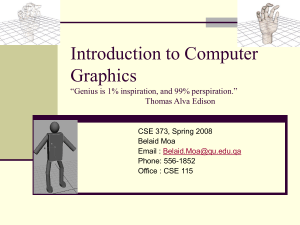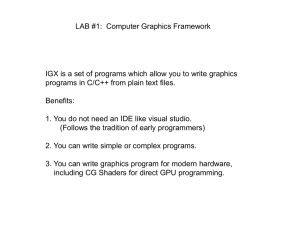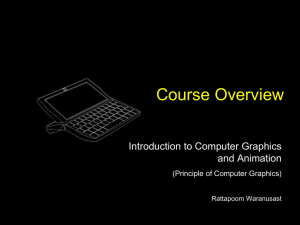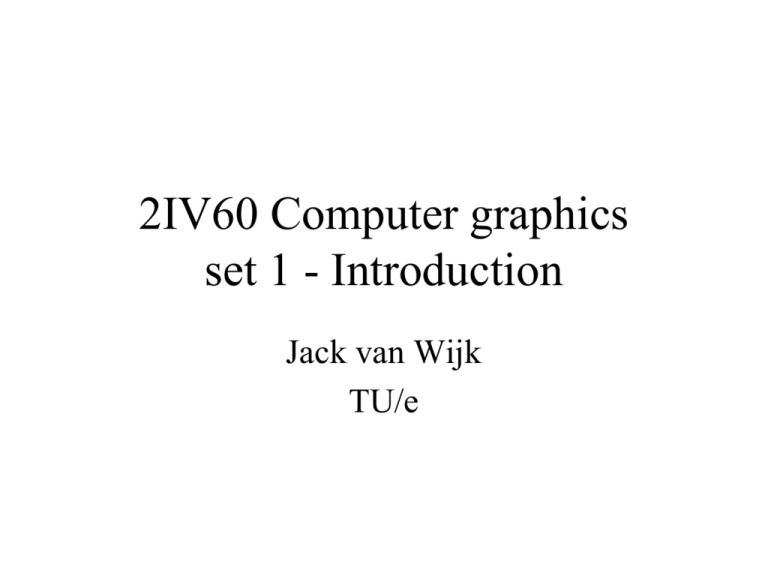
2IV60 Computer graphics
set 1 - Introduction
Jack van Wijk
TU/e
2IV60 Computer graphics
• Aim:
Knowledge basic concepts 2D en 3D
computer graphics
• Lectures & instructions
• Assessment: Assignments and exam
Topics 2IV60
1.
2.
3.
4.
5.
6.
7.
Introduction
Basic math for graphics
Transformations
Viewing
Geometric modeling
Shading and illumination
Visible surfaces
Lectures
16 lectures of two hours (max.)
•
•
•
•
•
Overview of material
Details (esp. algorithms, math.)
Elaboration home-work exercises
Questions!
Demo’s
Home-work exercises
•
•
•
•
•
•
Each week a new set
Voluntarily, but recommended
Check if things are understood
Explanation later in lecture
Preparation for exam (50%)
Grade for exam should be at least 5.0 to pass
Instructions
16 instructions (max.)
•
•
•
•
Instructors and student assistants
Home-work exercises (mondays)
Assignments (thursdays)
Questions!
Assignments
• Modeling and visualizing moving robots
Assignments
•
•
•
•
•
•
•
•
Modeling and visualizing moving robots
Java + OpenGL
Two rounds
Deadlines: after week 3 and 7:
30/11/2015, 11/1/2016.
To be done in pairs
Submit: source code via Peach
Judged: problem solved + explanation in comment
source code
40% of final result (14% first round, 26% second)
Intermediate exam
•
•
•
•
•
Check if course material has been understood
Individual
Two hours
December 14, during instruction hours
10% of final result
Course material
• Book (recommended, not obligatory):
– Donald Hearn, M. Pauline Baker, Warren
Carithers. Computer Graphics with OpenGL,
4th edition, Pearson Prentice Hall, paperback.
•
•
•
•
•
Study guide
Slides
Homework exercises and answers
Oase.tue.nl
http://www.win.tue.nl/~vanwijk/2IV60
Why computer graphics?
• Fun! Visible!
• Everywhere
• Visual system offers:
– Parallel input
– Parallel processing
• Computer graphics: ideal for humancomputer communication
Applications
• Graphs and charts
• Computer-Aided
Design
• Virtual Reality
• Data Visualization
• Education and training
•
•
•
•
Computer Art
Movies
Games
Graphical User
Interfaces
H&B 1:2-32
Business graphics
H&B 1:2-32
Computer-Aided Design
• AutoDesk
• IAME 2-stroke race kart engine
Data Visualization
Bruckner and Groeller,
TU Vienna, 2007
Holten, TU/e, 2007
H&B 1:2-32
Gaming
H&B 1:2-32
expression
depth of field
Movies
fracture
motion
water
reflection
hair
H&B 1:2-32
Hardware
• Fast development
• History: see book
• Now: Graphics Processing Unit (GPU),
LCD-screen
Beyond the laptop screen
• Microsoft Surface
• Apple iPad
Beyond the laptop screen
• Roll-up screen, Philips
Beyond the laptop screen
• 24 screen configuration, Virginia Tech
• 50 LCD touchscreens
Beyond the laptop screen
• Reality Deck – Stony Brook University
• 416 2560×1440 27” monitors
Beyond the laptop screen
Head mounted displays
Parachute trainer
US Navy
Beyond the laptop screen
• Oculus Rift
Schematic
Model
Display
interaction
User
Image
Also…
Computer
Graphics
Model
Image
Pattern
Recognition
Image
Processing
From model to image
Model
World
View
NDC
Display
Graphics pipeline
Coordinates and transformations
H&B 3-1:60-61
From model to image
Model
World
View
NDC
Display
Cylinder:
x2 y2 r 2
0 zh
Local or modeling coordinates
Geometric modeling
H&B 3-1:60-61
From model to image
Model
World
View
NDC
Display
Position cylinders in scene:
World coordinates
H&B 3-1:60-61
From model to image
Model
World
View
NDC
Display
Look at cylinders,
project on virtual screen
Viewing coordinates
Visible surfaces, shading
H&B 3-1:60-61
From model to image
Model
World
View
NDC
Display
Display:
1
0
Normalized Device Coordinates
1
H&B 3-1:60-61
From model to image
Model
World
View
NDC
Display
Display on screen:
0
1024
768
Device Coordinates
Interaction
H&B 3-1:60-61
Generating graphics
• Special-purpose programs
– Photoshop, Powerpoint, AutoCAD, StudioMax,
Maya, Blender, PovRay, …
• General graphics libraries and standards
– Windows API, OpenGL, Direct3D,…
H&B 3-2:61-62
CG standards
• Set of graphics functions, to be called from
programming language
• Access to and abstract from hardware
• Standardization
Fortran, Pascal, …
Display
Input dev.
C, C++, Java, Delphi,…
CG API
Drivers
Display
Input dev.
1975
2000
Functions
• Graphics Output Primitives
– Line, polygon, sphere, …
• Attributes
– Color, line width, texture, …
• Geometric transformations
– Modeling, Viewing
• Shading and illumination
• Input functions
H&B 3-2:61-62
Software standards
•
•
•
•
GKS, PHIGS, PHIGS+ (1980-)
GL (Graphics Library, SGI)
OpenGL (early 1990s)
Direct3D (MS), Java3D, VRML,…
H&B 3-3:62-63
OpenGL
•
•
•
•
•
•
•
3D (and 2D)
Fast
Hardware, language, OS, company independent
OpenGL architecture review board
Broad support
Low-level (right level!)
Standard graphics terminology
H&B 3-5:64-72
Intro OpenGL
•
•
•
•
•
Few basic principles
No questions asked at exam
Needed for assignments
Here: OpenGL 1.1
Modern versions (incl. WebGL): closer to
hardware, older versions easier to
understand
H&B 3-5:64-72
More info on OpenGL
• http://www.opengl.org,
http://www.opengl.org/sdk/docs/man2/
• The Red Book:
http://www.glprogramming.com/red/
• Many other web-sites
• No need to learn by head, aim at
being able to read manual pages
OpenGL, GLU and GLUT
• OpenGL: basic functions
• GLU: OpenGL Utility library:
• GLUT: OpenGL Utility Toolkit library
• GLU and GLUT:
– Handy functions for viewing and geometry
H&B 3-5:64-72
OpenGL and Java
• C: glFunction();
gluFunction(); glutFunction();
• Java: JOGL
gl.glFunction();
glu.gluFunction();
glut.glutFunction();
• No windowing functions offered by JOGL
• Assignment: skeleton offered
OpenGL syntax
• Functions:
glFunction: glBegin, glClear, glVertex, …
• Constants:
GL_CONSTANT: GL_2D, GL_LINE
• Datatypes:
GLtype: GLbyte, GLint, GLfloat
H&B 3-5:64-72
Example
glClearColor(1.0,1.0,1.0,0.0);// Background color
glMatrixMode(GL_PROJECTION); // Set transformation
glLoadIdentity;
gluOrtho2D(0, 200, 0, 150);
glClear(GL_COLOR_BUFFER_BIT); // Clear background
glColor3f(1.0, 0.0, 0.0);
glBegin(GL_LINES);
glVertex2i(180, 15);
glVertex2i(10, 145);
glEnd;
glFlush;
//
//
//
//
//
//
Set color to red
Draw line
- first point
- second point
Ready with line
Send
H&B 3-5:64-72
Example
Example 3D
•
•
•
•
Quick, minimal example
Lots of jargon and new material
Motivate studying theory
Enable quick start assignment
• Here: viewing and modeling transformations
H&B 3-5:64-72
Example 3D
Aim: Draw two rectangular boxes
1. Set up viewing transformation
2. Specify the colors
3. Draw the objects
Example 3D
// Set up viewing transformation
glViewport(0, 0, 500, 500);
// Select part of window
glMatrixMode(GL_PROJECTION); // Set projection
glLoadIdentity();
glFrustum(-1.0, 1.0, -1.0, 1.0, 4.0, 20.0);
glMatrixMode(GL_MODELVIEW);
glLoadIdentity();
gluLookAt(3.0, 6.0, 5.0,
1.0, 0.0, 0.0,
0.0, 0.0, 1.0);
// Set camera
- eye point
- center point
- up axis
Example 3D
// Clear background
glClearColor(1.0,1.0,1.0,0.0);// Background color
glClear(GL_COLOR_BUFFER_BIT); // Clear background
// Set color
glColor3f(0.0, 0.0, 0.0);
// Set color to black
Example 3D
// Draw two rectangular boxes
glutWireCube(1.0); // unit box around origin
glTranslatef(2.0, 0.0, 0.0); // move in x-direction
glRotatef(30, 0.0, 0.0, 1.0); // rotate 30 degrees
around z-axis
glScalef(1.0, 1.0, 2.0);
// scale in z-direction
glutWireCube(1.0); // translated, rotated, scaled box
Example 3D
glutWireCube(1.0); // unit box around origin
glTranslatef(3.0, 0.0, 0.0); // move in x-direction
glRotatef(30, 0.0, 0.0, 1.0); // rotate 30 degrees
around z-axis
glScalef(1.0, 1.0, 2.0);
// scale in z-direction
glutWireCube(1.0); // translated, rotated, scaled box
Note:
• Objects are drawn in the current local axis-frame;
• With transformations this frame can be changed.
Next
• Next lectures:
– Basic math
– 2D and 3D transformation
– 2D and 3D viewing

